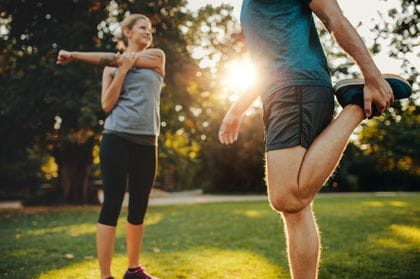The A-Z of Running
The 7 most important things you should bear in mind for running
Anyone can run: It is the most natural means of movement for humans – apart from walking. Running as a sport, however, has a quite different focus. From the warm-up to the finish line, there is a great deal of advice that can make running a real pleasure. We have summarised the most important aspects for you.

1) Running training
Choose your type of running training
Before you enter the starting blocks, consider exactly what you want to achieve with your running. Is it about endurance training or primarily about burning fat to lose weight? Do you want to train for a marathon with interval running training or do you enjoy jogging to clear your head? Depending on the goal you set, your running training will look different as regards duration, frequency and intensity. Decide what your motivation is and set yourself realistic goals.
2) Running shoes
Finding the right running shoes
Your legs and feet are absolutely unique. Their length, width and anatomical nature must be observed when choosing your running shoes. In the Bründl Sports shops, you can have a running analysis, which provides a solid basis for the recommendation of particular running shoes. You can save money on your running outfit, but never on your shoes. After all, they have to carry you painlessly through the countryside, over stick and stone, for many kilometres.

3) Running technique
Learning to run correctly: The technique
An incorrect running technique leads to pain, sooner or later. For this reason, make sure that you maintain the correct posture. With the right technique, you can achieve an economic running style, where you can use power and speed better and more easily. The support phases and float phases during running should feel light and good; do not take any excessively long steps and only lift your knees as high as they naturally go. The best way to strengthen coordination, balance and power is by running off-road. If you are not sure that your running technique is right, ensure that you obtain advice from a coach.
4) Running training plan
A running training plan will get you there
Once today and maybe tomorrow ... you will never achieve your goal that way. Work out a realistic plan before the first running training session. Overstraining at the beginning, in particular, quickly leads to frustation and, at worst, to injuries. A good training plan is based on your running fitness when you begin, and then slowly increases the demands made on your performance. You can find plans for various types of running training on the internet, but planning and monitoring by a personal trainer is more individual.
5) Warm up
Warm up before the running training
Do you already have a warm, fuzzy feeling thinking about the first circuit on the track? Stop! First, you have to warm up. Plan approx. five to ten minutes for this important first phase of your running training. During this time, your circulation, metabolism, and oxygenand nutrient supply to the cells are prepared for running, your joints are lubricated, and acidification of the muscles is prevented. You can set off running slowly and build in a few exercises for flexibility and power – just like in any other sport.

6) Breathing and pulse
Focus on your breathing and cardiac rhythm
Depending on how you structure your running training, your heart rate will be faster or slower, and your cardiovascular system will be exposed to various loads. This is important to achieve your training goal, but the demands should be placed on your body in a controlled manner. The training plan (for orientation) and a heart rate monitor will help you in this – regardless of the performance level at which you are training. Avoid both excessive strain and insufficient strain: Keep on readjusting your training to your performance.
7) Cool down & Stretching
Cool down and stretching to finish
The cool-down, or limbering down, is very easy in running training: You simply run the last approx. five minutes very slowly, allow your body to return to a near-resting state and feel how your body calms down and your pulse slows. Depending on your condition and the exercise, you will notice that your body enters the subsequent recovery phase more quickly. Conclude your running training with stretching exercises. This is necessary because your muscles shorten as a result of the running, which can lead to movement restrictions and pain. Thorough stretching makes your muscles, tendons and ligaments supple and fit for your next running session.

thomas-marzusch.jpg)


